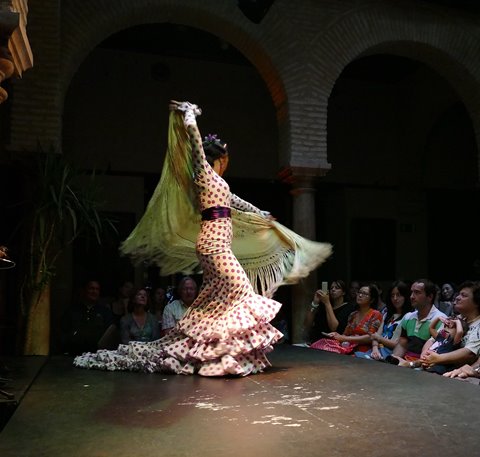Flamenco dance
Flamenco dance goes with different palos or varieties. It is similar to a moderate physical activity and has beneficial effects on physical and emotional health. From this arose the idea of “flamencotherapy”
The beating of feet or the furious passion is what characterizes flamenco dance. This dance, means the third part of the flamenco art, and has a historical background accompanied by the development of the Spanish culture.
Origin and evolution of flamenco dance
Its origin is located in the marginal villages of the south of Spain. Both dance and flamenco music had an ancient influence of the Greeks and Romans. Later, it was influenced by the Arabs, Jews and even Hindus. With the arrival of Muslims and Jews to the Iberian Peninsula, the already booming music and dance, which was born in Andalusia, extracted characteristics from these cultures.
Therefore, the flamenco dance and music of today, are the result of centuries of influence and unification of multicultural elements.
Thanks to the blooming development of flamenco music, came also quickly the evolution of dance, appearing for the first time in a structured and recognizabled way in the eighteenth century.
The passionate dancers impressed the audience in the cafés cantantes of this period. Quickly, flamenco dancers began to be more popular the singers. After centuries of cultural fusion, an art, which was born in caves as a form of expression for the Roma and other cultures which were oppressed, has evolved in a remarkable way. The result is a fusion between singing and flamenco dancing, which has seduced the entire world.
Depending on the emotional opinion, the melodic phrases and different traditions of each flamenco singing, flamenco dance is manifested in more than fifty different palos. Both music and flamenco dance include a strong personal improvisation and in this way, flamenco dance creates itself, thanks to spontaneous expressions of the emotions of the flamenco dancer any particular moment.
How flamenco dancers perform
In a performance, flamenco dancers usually remain motionless for the first few notes of the melody. He absorbs the strumming of the guitar, the palms and singing, until he gets the inspiring blow. He or she will then begin with a passionate dance with the beat of the song. We can even get to see facial expressions of in the face of the dancer during the performance.
Flamenco dancers essentially interpret, following the song's lyrics and performing in a smooth and elegant way, which contrast with vibrating bumps of the feet striking strongly against the floor. Duets, which are usually composed of a man and a woman, are normally more intense dances. In these cases, dancers have a constant eye on the show. The result is a passion competition between the two dancers.
